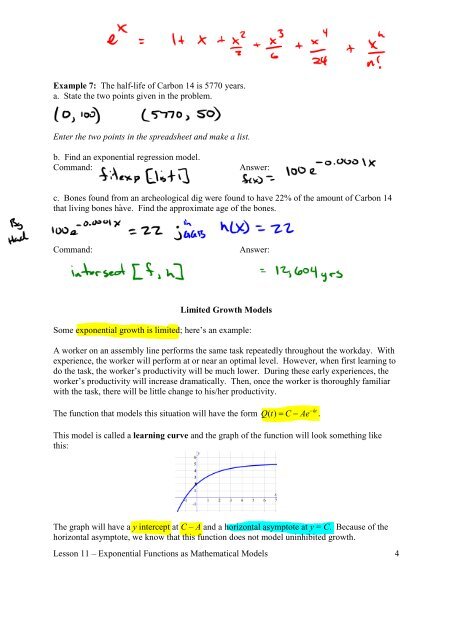Day 7 - UH Department of Mathematics
Day 7 - UH Department of Mathematics
Day 7 - UH Department of Mathematics
Create successful ePaper yourself
Turn your PDF publications into a flip-book with our unique Google optimized e-Paper software.
Example 7: The half-life <strong>of</strong> Carbon 14 is 5770 years.<br />
a. State the two points given in the problem.<br />
Enter the two points in the spreadsheet and make a list.<br />
b. Find an exponential regression model.<br />
Command:<br />
Answer:<br />
c. Bones found from an archeological dig were found to have 22% <strong>of</strong> the amount <strong>of</strong> Carbon 14<br />
that living bones have. Find the approximate age <strong>of</strong> the bones.<br />
Command:<br />
Answer:<br />
Limited Growth Models<br />
Some exponential growth is limited; here’s an example:<br />
A worker on an assembly line performs the same task repeatedly throughout the workday. With<br />
experience, the worker will perform at or near an optimal level. However, when first learning to<br />
do the task, the worker’s productivity will be much lower. During these early experiences, the<br />
worker’s productivity will increase dramatically. Then, once the worker is thoroughly familiar<br />
with the task, there will be little change to his/her productivity.<br />
The function that models this situation will have the form Q( t)<br />
= C − Ae −kt .<br />
This model is called a learning curve and the graph <strong>of</strong> the function will look something like<br />
this:<br />
The graph will have a y intercept at C – A and a horizontal asymptote at y = C. Because <strong>of</strong> the<br />
horizontal asymptote, we know that this function does not model uninhibited growth.<br />
Lesson 11 – Exponential Functions as Mathematical Models 4
















